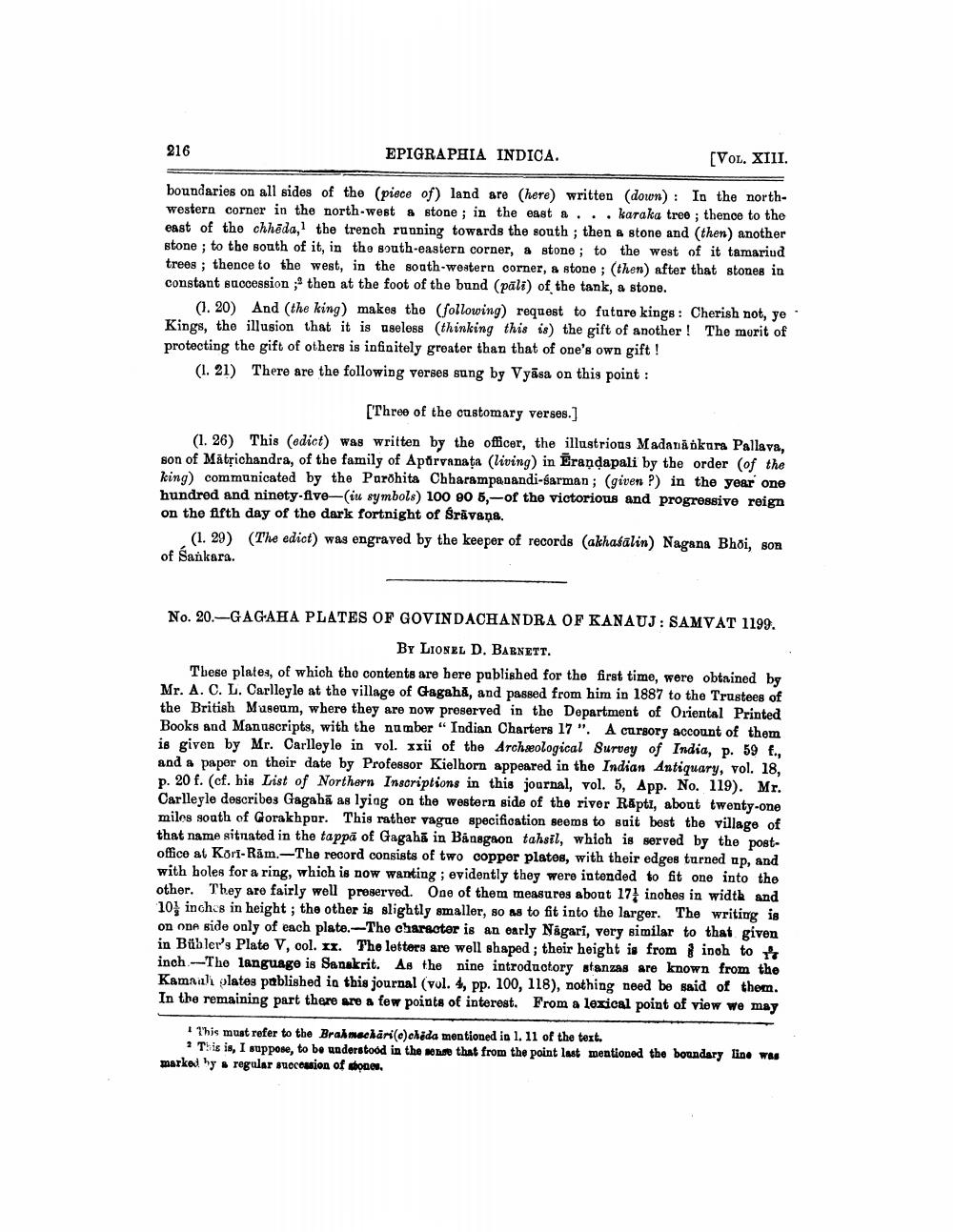________________
216
EPIGRAPHIA INDICA.
[VOL. XIII.
boundaries on all sides of the (piece of) land are (here) written (down): In the northwestern corner in the north-west a stone; in the east a . . . .. karaka tree; thence to the east of the chheda, the trench running towards the south; then a stone and (then) another stone; to the south of it, in the south-eastern corner, a stone; to the west of it tamarind trees; thence to the west, in the south-western corner, a stone; (then) after that stones in constant succession ; then at the foot of the bund (pali) of the tank, a stone.
(1.20) And (the king) makes the (following) request to future kings: Cherish not, ye Kings, the illusion that it is useless (thinking this is) the gift of another! The merit of protecting the gift of others is infinitely greater than that of one's own gift!
(1.21) There are the following verses sung by Vyasa on this point:
[Three of the customary verses.]
(1.26) This (edict) was written by the officer, the illustrious Madanankura Pallava, son of Matrichandra, of the family of Apurvanata (living) in Eranḍapali by the order (of the king) communicated by the Purohita Chharampanandi-sarman; (given ?) in the year one hundred and ninety-five-(iu symbols) 100 90 5,-of the victorious and progressive reign on the fifth day of the dark fortnight of Śrāvana.
(1. 29) (The edict) was engraved by the keeper of records (akhafalin) Nagana Bhoi, son of Sankara.
No. 20.-GAGAHA PLATES OF GOVINDACHANDRA OF KANAUJ: SAMVAT 1199. BY LIONEL D. BARNETT.
These plates, of which the contents are here published for the first time, were obtained by Mr. A. C. L. Carlleyle at the village of Gagaha, and passed from him in 1887 to the Trustees of the British Museum, where they are now preserved in the Department of Oriental Printed Books and Manuscripts, with the number "Indian Charters 17". A cursory account of them is given by Mr. Carlleyle in vol. xxii of the Archaeological Survey of India, p. 59 f., and a paper on their date by Professor Kielhorn appeared in the Indian Antiquary, vol. 18, p. 20 f. (cf. his List of Northern Inscriptions in this journal, vol. 5, App. No. 119). Mr. Carlleyle describes Gagaha as lying on the western side of the river Rapti, about twenty-one miles south of Gorakhpur. This rather vague specification seems to suit best the village of that name situated in the tappa of Gagaha in Banagaon tahsil, which is served by the postoffice at Kōri-Ram.-The record consists of two copper plates, with their edges turned up, and with holes for a ring, which is now wanting; evidently they were intended to fit one into the other. They are fairly well preserved. One of them measures about 17 inches in width and 10 inches in height; the other is slightly smaller, so as to fit into the larger. The writing is on one side only of each plate.-The character is an early Nagari, very similar to that given in Bühler's Plate V, col. xx. The letters are well shaped; their height is from inch to inch-The language is Sanskrit. As the nine introductory stanzas are known from the Kamaal plates pablished in this journal (vol. 4, pp. 100, 118), nothing need be said of them. In the remaining part there are a few points of interest. From a lexical point of view we may
This must refer to the Brahmachari (c) cheda mentioned in 1. 11 of the text.
2 This is, I suppose, to be understood in the sense that from the point last mentioned the boundary line was marked by a regular succession of stones.




